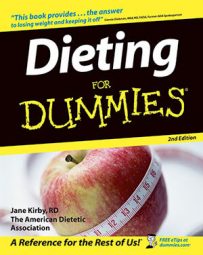Finding your healthy weight range
Ever wonder what your ideal weight would be? You can quickly estimate your healthy weight range, with these simple formulas. They take your height and gender into account.
Men: 106 pounds for 5 feet, plus 6 pounds per inch over 5 feet or minus 6 pounds per inch under 5 feet; plus and minus 10 percent.
Women: 100 pounds for 5 feet, plus 5 pounds per inch over 5 feet or minus 5 pounds per inch under 5 feet; plus and minus 10 percent.
For example, a six-foot man would calculate his healthy weight range like this:
106 + (6 x 12) = 178
178 +/- 10% = 160 to 196 pounds
A woman who measures 5 feet and 5 inches, would calculate her healthy weight range like this:
100 plus (5 x 5) = 125
125 +/- 10% = 113 to 137 pounds
You’ll be at the higher end of the range if you’re large-framed or carry more muscle, and at the lower end of the range if you’re small-framed with less muscle.
How calories relate to dieting
Protein, carbohydrate, and fat make up the calorie content of all foods. Although not considered a nutrient, alcohol also provides calories. Take a quick look at what various foods add up to calorie-wise:
-
1 gram of protein contains 4 calories.
-
1 gram of carbohydrate contains 4 calories.
-
1 gram of fat contains 9 calories.
-
1 gram of alcohol contains 7 calories.
The remaining nutrients — water, minerals, and vitamins — don’t provide calories nor does fiber or cholesterol.
Because there are 3,500 calories in a pound and 7 days in a week, you must cut your daily calorie intake by 500 to lose 1 pound a week (3,500 divided by 7 = 500).
To lose 1-1/2 pounds per week, you need to cut 750 calories a day. A 2-pounds-a-week loss means eliminating 1,000 calories a day. A faster rate of weight loss is generally associated with weight regain and yo-yo dieting. Eating less is one way to cut calories, but if you add exercise, you don’t have to restrict your intake so severely to lose the weight that you want to lose.
8 tips for creating healthy eating habits
Living and eating well involves more than just counting calories, reducing carbs, or watching fat. Remember these eight easy guidelines for healthy eating. If you are overweight and start following these tips, you should start losing weight naturally.
-
Eat a minimum of three servings of vegetables and two servings of fruit each day.
-
Eat at least three servings of whole grains each day.
-
Eat at least four servings of beans, lentils, or peas each week.
-
Eat three meals and two to three small snacks a day.
-
Eat breakfast.
-
Limit or eliminate soft drinks and drink plenty of water.
-
Limit caffeine to two servings or less a day.
-
Limit salty foods and the amount of saturated fat that you eat.
Trim fat to trim calories
Eating less fat is one of the easiest ways to cut calories and lose weight. If you’re looking to cut some of the fat (and therefore calories) out of your diet, follow some of these helpful hints:
-
Use fats and oils sparingly.
-
Eat plenty of grain products, vegetables, and fruits.
-
Choose lean or extra-lean meats, fish, and poultry, and trim off any visible fat. For beef, look for the word round or loin in the name, which indicates that it’s a lower-fat cut — such as sirloin, ground round, or top round.
-
Use small amounts of lowfat salad dressing, whipped butter or margarine, and lowfat or fat-free mayonnaise.
-
Use herbs, spices, lemon juice, and fat-free or lowfat salad dressings for seasoning.
-
Consume few high-fat processed meats, such as sausage and cold cuts.
-
Up your intake of beans, such as kidney, pinto, and Great Northern, and bean products. Not only are most of these foods nearly fat-free, but they’re also a good source of protein and fiber.
-
Choose fat-free or lowfat (1%) milk, fat-free, or lowfat yogurt, and reduced-fat or lowfat cheeses.

